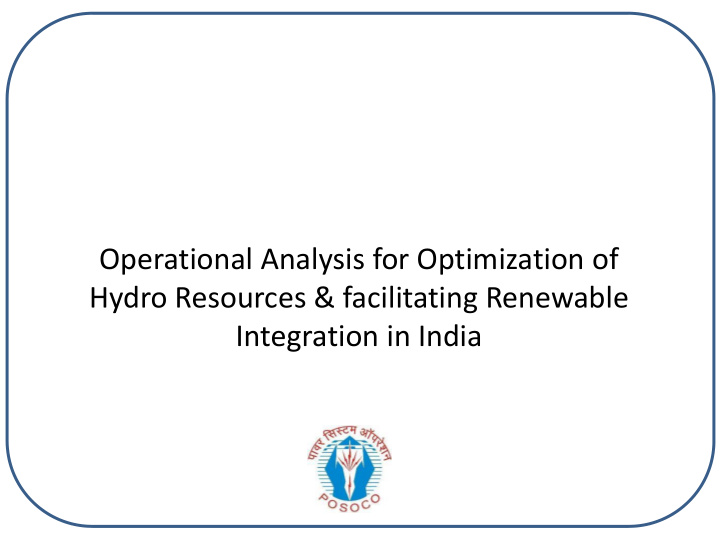



Operational Analysis for Optimization of Hydro Resources & facilitating Renewable Integration in India
Chronology • 21-Nov-2016 : Working Group on Hydro Resource (18th FOLD) • 16-Feb-2017 : Survey Questionnaire Distribution & interaction 18-Apr-2017 : 1 st Meeting of the FOLD WG at NLDC, New Delhi • • 09-Jun-2017 : Draft Report circulated for comments 19-Jun-2017 : Report endorsed by FOLD in the 19 th Meeting • • : Release of Report by Hon’ble MOSP (at 60 th FoR) 23-Jun-2017 • 28-Jun-17 : Review by Joint Secretary (Hydro), MoP, GoI • 10-Jul-2017 : Constitution of MoP Sub-Committee(Hydro) : 1 st Meeting of MoP-Subcommittee (Hydro) • 12-Jul-2017 : 2 nd Meeting of MoP-Subcommittee (Hydro) • 14-Jul-2017 : 3 rd Meeting of the Subcommittee (Hydro) thru. VC • 17-Jul-2017 6/12/2017 2
Motivation • Sub optimal operation of some hydro generators – Scope for optimization & flexible operation along with economic gains – Requirement of flexibility in view of large scale Renewable Integration • Hydro Power - a source of flexibility & reliability • Overload capability • Peaking support • Fast ramping • Primary Response • Voltage Regulation • Black Start Capability • Constitution of FOLD Working Group
FOLD Working Group on Hydro (21-Nov-2016) Terms of Reference(ToR): 1. To study the existing capability of hydro stations in States and Interstate level 2. To study the existing tariff and operating norms for hydro stations 3. To study the prevailing practices for scheduling and utilization of available capabilities of hydro stations and the existing constraints/issues withholding full utilization. 4. To study the operating constraints in respect of inflows, hydrology, water release, rate of reservoir depletion, machine capabilities etc.
Terms of Reference(ToR) 5. To explore the possibilities for utilizing available hydro stations as a flexible resource for primary response, secondary control (AGC), load following, peaking, pumped storage, reactive energy, Black-start etc. 6. To explore the possibilities of integrated operation of tandem hydro stations or stations on same river basin. 7. To study the availability of existing communication facility between the stations and control centers. 8. To suggest possible mechanisms and regulatory interventions for optimizing/enhancing utilization of existing hydro capabilities without violating the identified constraints. 9. Any other related matter.
Flexible Resources for Grid Operation Hourly Variation in all- to manage variability of demand & RE India Demand (2008-17) generation: - Flexible Hydro / Gas generation - Grid level Energy Storage The envelope is likely to widen further due to changes in load pattern 6
(Typical winter day) All India Demand Ramp Rate :- 91 MW/Min All India Demand Ramp Rate :- 156 MW/Min All India Hydro Generation Ramp Rate :- 112 All India Hydro Generation Ramp Rate :- 59 MW/Min MW/Min (Time considered 16:30 Hr to 18:00 Hr) (Time considered 04:00 Hr to 07:00 Hr)
18-12-2017 ER Demand Ramp Rate :- 49 MW/Min ER Hydro Generation Ramp Rate :- 29 MW/Min (Time considered 16:30 Hr to 17:45 Hr)
Odisha Hydro generation 15 th Feb-2018 to 28 th Feb-2018 Installed capacity :- 2027.5 MW 655 MW outage Available capacity :- 1372 MW Long Outage Forced Outage Burla 75 : U-5(37.5 mw), U-6(37.5 mw) 81.5: U-2(49.5 mw) U-4(32 mw) Chipilima 24 :U-3 (24mW) Rengali 50: U-5(50 mw) Balimela 195 : U-1(60 mw)U-7(75 Mw) U-2(60Mw) Up Kolab 80 : U-2(80 Mw) Indravati 150 U-3(150 Mw) 374 281.5 Total:
EI Capacity = 117 Mw U-5 :37.5 MW: R&M work: 25-10-2016 EI Capacity = 163 Mw U-6 :37.5 MW: R&M work: 16-10-2015 U-5&6 were Out and U-7 :37.5MW: GT Problem U-2&7 restored U-2: 49.5 MW: Maint: From Mid May EI Capacity = 130 to 140 Mw - U- 5&6 were Out for R&M and add One M/C out for short Maint Effective Installed capacity over the period was less due to outage of multiple units for different reasons. U- 5 & 6 were out for R&M work since 2015 Around 30 to 40 MW less generation during Peak as per the Units on Bar
Eff. Instl. Capacity = 375 Mw U-1 out for R & M work since 05- 08-16 U-7 Out for Stator problem Available capacity over the period was less due to long outage of U-1(60 MW), U-2(60 MW) for R&M Work and U-7(75 MW) for Gen stator Problem Around 50 MW less generation during Peak
Achieves Peak generation of 600 MW on daily Basis During Nov to Dec – 17 and Feb- 18 period One unit was out for maintenance work
EI Capacity = 150 Mw U-3(50 MW): 21-03-17 : Hoist Gate Problem EI Capacity = 200 Mw U-1(50 MW):25-08-17 to U-3(50 MW): 21-03-17 Oct-17 Stator Earth Fault : Hoist Gate Problem Effective Installed capacity over the period was less due to long outage of U-3 (50 Mw) for Hoist Gate Problem and from Dec Onward one unit Outage for Short Maintenance work.
EI Capacity = 160 Mw U-2 (80MW)-28-05-17: MIV Problem U-3 (80MW)- Since May-17:-Gen Internal fault SCADA data unavailable till Mid July Effective Installed capacity over the period was less due to long outage of U-2 (80 Mw) for repair of MIV and draft tube gate Leakage
One unit was out for maintenance Pumping mode operation
Conclusions • Despite having a hydro fleet of more than 1900MW capacity, around 1400MW (average) only of OHPC was available for generation at any point of time. • By optimizing maintenance plan and avoiding long outages due to breakdown, additional 400MW capacity can be harnessed for providing peaking support • Purulia PSP operation (both generating and motoring) can be utilised as a flexible resource with appropriate incentives. • Complexity in despatching plants with their reservoirs in tandem with upstream plant being scheduled as per day-ahead short-term market requirement while downstream plant schedule has to meet obligations towards its long-term beneficiaries.
Teesta – III & Teesta – V Dispatch Pattern during lean hydro inflow
Thank You !
Recommend
More recommend